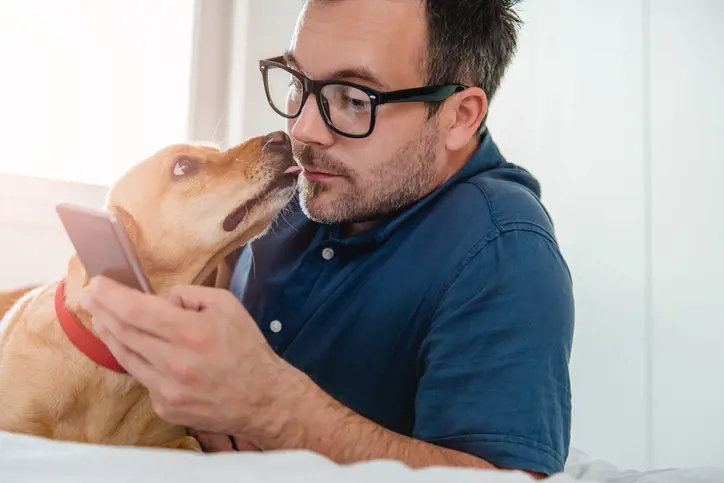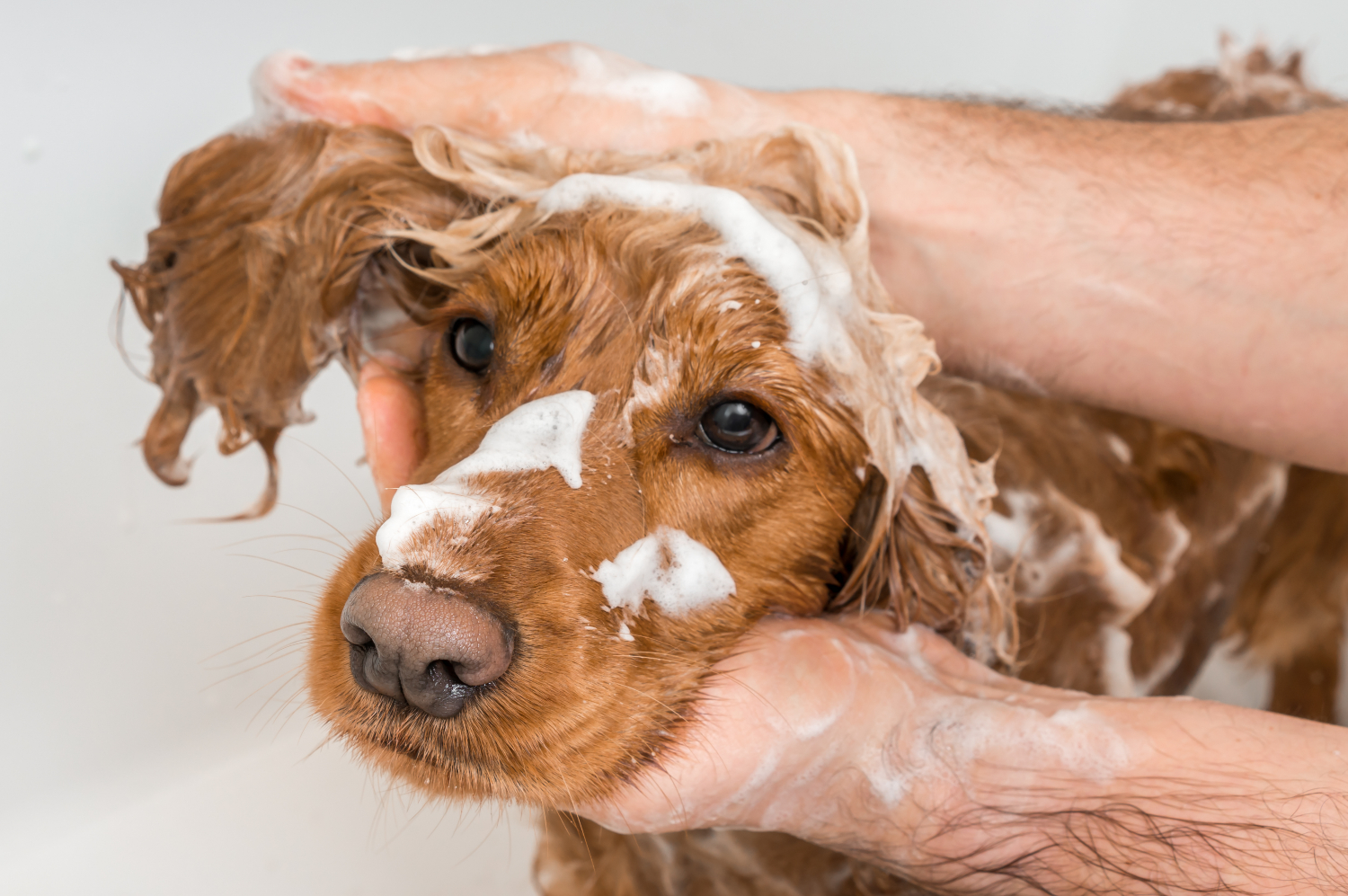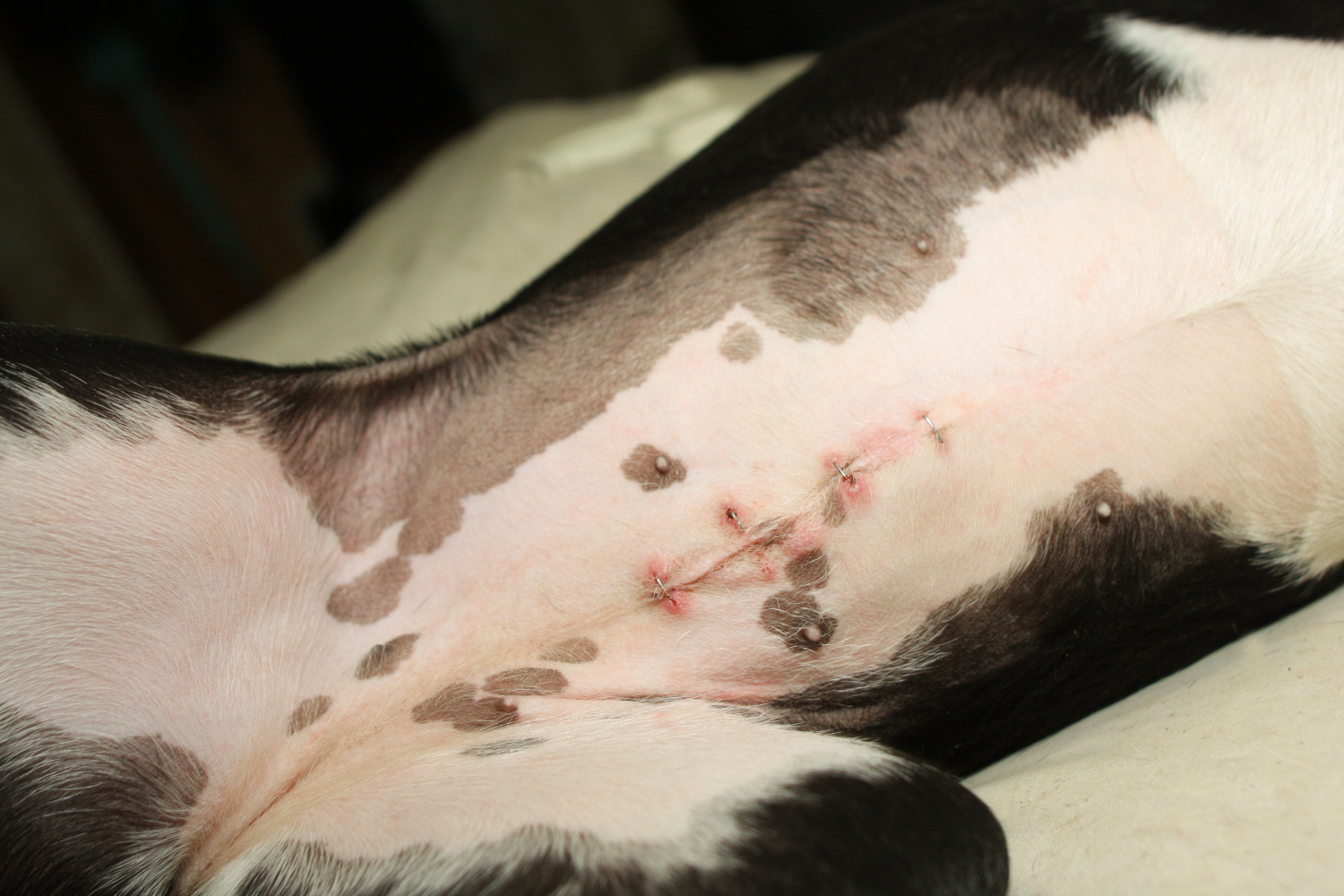How to help a dog in season
9th January, 2020

Dogs go into heat every 6 or 7 months, but how can you tell when they are in season? Purely Pets share what it means to be in heat and what you can do to help your faithful friend feel more comfortable.
If you’re hoping to breed your dog, you might be eagerly awaiting her next season. For those who don’t want a litter of puppies, the words ‘in heat’ can make you a little nervous.
Discover the tell-tale signs that your pet is coming into season and how you and she can cope with the physical and behavioural changes that she’ll go through.
We answer some of the common questions surrounding the subject and give you some tips on what to do if you don’t want your dog to get pregnant.
If you have any further queries about your pet going into heat, contact your vet. If you have dog insurance lifetime cover with Purely Pets, you can use our 24-hour vet video consultation service for quick advice.
What does it mean for a dog to be ‘in season’?
The term ‘in season’ (or ‘in heat’) refers to the time when a female dog is fertile and able to get pregnant.
During this time, canines often act differently, bleed and might show a much keener interest in male dogs. The experience isn’t painful for your pet, but it might make her uncomfortable.
Behavioural problems and health concerns can arise in any female dog, but some are much more likely if they aren’t spayed.
Make sure you have dog insurance lifetime cover to protect your pet. Having an insurance policy in place means you can get emergency care for your pooch when she needs it most without having to worry about an unexpected vet .
It is important to note that pet insurance covers accidents and illnesses, so some insurers may not cover pets that are used for breeding. Pregnancy tends to be a common exclusion on pet insurance so you may need to seek out getting specialist insurance.
When do dogs have their first season?
Once a bitch becomes mature (usually between 6 months and 2.5 years of age), they have their first season. Most have them sooner rather than later, but don’t be surprised if yours doesn’t come into heat until she’s turned 2.
After this, your dog will go into season every 6 to 7 months or twice a year. This can vary when she’s young and can take up to 18-24 months to become regular. Smaller dogs might also come into season more often, with some experiencing 3-4 in a year.
As she ages, the gaps between might get bigger, but she will never stop going into heat. Each season will last around 2 to 4 weeks. Even though you might not notice symptoms for the whole duration, she can become pregnant at any time.
If you’re concerned about your pet not having her first season, contact your vet. If there’s any underlying health issues causing your four-legged friend to be infertile, she might need further treatment.
Your dog insurance lifetime cover can help you financially if they need treatment or medication in an for an accident or illness. However, you should be aware that anything pregnancy related is usually excluded.
What time of year do dogs go into season?
There’s no specific time of year that a dog goes into heat – it depends on her individual cycle.
As we mentioned, most have two seasons a year, but very small breeds might have up to four. As your pet matures, you’ll become familiar with her cycle and know when to expect her to come into heat.
How can you tell your dog is in heat?
When your bitch starts her season, there are a few symptoms to look out for so you can keep her comfortable during this time and prevent unwanted pregnancies.
There are various physical and behavioural changes, which include:
-
A large, swollen vulva
-
Bleeding from the vulva
-
Frequent urination
-
Excessive licking of her back end
-
Increased aggression
-
Bigger or smaller appetite
-
Tail tucking
-
More attention from male dogs
-
Roaming and looking for males
-
Mounting and humping
Not all dogs display every symptom during heat, and some might make it difficult for you to know their season has started. To help you stay on high alert and avoid her getting pregnant, we go into more detail about each tell-tale sign below.
Changes to the vulva
Your dog’s vulva will swell a lot and appear much larger than its usual size. It may also look red and protrude, but this isn’t usually anything to worry about.
If you think your four-legged friend’s vulva is causing her discomfort during heat, contact your vet or use the 24-hour video consultation service if you have dog insurance with lifetime cover with Purely Pets.
Bleeding from the vulva
Pet parents often think the bleeding during a dog’s season is their period, but it actually signals they are at their most fertile. The lining of the uterus has become soft and ready to grow a litter of puppies if she falls pregnant.
As well as the blood around the vulva, you might see some spotting on the floor or a yellow, brown, or red discharge.
If you notice white discharge, you’ll need to get your pet checked by the vet as it could be a sign of infection.
Weeing more than usual
It’s normal for a female dog to start urinating more than she usually does when she’s in heat, but if it seems excessive, call the vet.
Excessive weeing could be another sign of infection, which she may need treatment for.
Licking their back end often
One of the most obvious signs your pet is in heat is excessive licking around her vulva. This is due to the swelling, bleeding, discharge, and increased urination.
More aggressive
Along with the various physical signals, you’ll also spot certain behavioural changes in your pet. She might become especially aggressive towards males she doesn’t want mating with her.
Keep her close to you when you leave the house to avoid unwanted scraps. The last thing you want is for your dog to need emergency treatment for an injury, which could see you claiming on your dog insurance, lifetime cover.
A change in appetite
Being in season can make some female canines excessively hungry, especially if they have become restless and are expending more energy. Others seem more lethargic and go off their food during this period.
Tucking tail between legs
If you spot your faithful female companion tucking her tail between her legs on walks, she might be protecting her vulva from unwanted male attention.
Attracting more attention from males
When your bitch is in heat, her wee contains pheromones and hormones that alert other pups she’s fertile. You might find that your dog, who could once stroll peacefully through the park, is now turning the heads of all males in sight.
Keep a close eye on your pet during this time as what appears to be a harmless sniff could turn into an unwanted litter of puppies a few months down the line.
Roaming for a mate
It’s not only the males that want to mate with your dog. During their season, females will often go in search of a mate, too, so be extra cautious when you leave the house and keep her on a lead.
Humping and mounting
Did you think it was only the male canines that humped every chair leg in sight? Think again. When bitches are in heat, don’t be surprised if you find her mounting her favourite toy or cushion or even another dog!
How long does a dog in season bleed?
Most dogs in heat bleed for 7-10 days. Some will experience very heavy bleeding while it’s almost unnoticeable in others. Don’t rely on this method to tell if your bitch is in season or not.
If your dog bleeds a lot in heat, you can try limiting her access to carpeted areas in your home and putting down towels to keep your house clean. If your furry female friend will let you, you can use a dog nappy to catch heavy bleeding.
Can I bathe my dog while she’s in heat?

It’s absolutely fine to give your faithful friend a bath while she’s in heat, and it can actually help her relax.
It can also help remove blood stains from your pet’s coat, which is particularly beneficial to those with light-coloured fur.
What are the 4 stages of a dog in heat?
The canine reproductive cycle is known as oestrus and involves four stages, each displaying changes to your dog physically and behaviourally.
-
Proestrus – This is the beginning of your dog being in season and lasts about 7-10 days. This is when you’ll notice changes to the vulva and bleeding. She might also attract males, but she isn’t ready to start mating yet.
-
Oestrus – This stage is the mating period and lasts 5-10 days. During this time, bleeding will slow down or stop, and your bitch is ready to mate.
-
Diestrus – The length of this stage differs greatly depending on whether your dog is pregnant or not. It could be as little as 10 days or last up to 140 days.
-
Anoestrus – This is the resting period or ‘down time’ before the next heat cycle begins. It usually lasts around 6 months.
Does a dog’s behaviour change when she is in season?
All dogs are different, and this means they each display varying behavioural changes when in heat. Don’t be surprised if your female companion either becomes overly clingy and demands more attention or is more aggressive and disobedient than normal.
If your faithful dog usually comes when called, she might now run off in search of a mate. This could cause her to get lost or into an accident and see you claiming on your dog insurance with lifetime cover.
As a caring pet parent, you know your dog better than anyone else and can spot the changes. If something is bothering you or you think your pup is suffering, don’t hesitate to call your vet.
How do I care for my dog when she’s in heat?
If your fertile canine mates when she’s in heat, you could be welcoming a litter of puppies in the near future. Pet parents who don’t want their dog to fall pregnant will need to take extra care during this period.
Your beloved pet will also need a little extra TLC for a few days, especially if she’s hormonal and feeling a little under the weather.
Use these tips to help keep your dog as comfortable as possible and make sure she avoids interactions with the males in town:
-
Keep your walks short.
-
Go out during quieter times of the day if possible and keep her on the lead.
-
Stay away from open areas where there are lots of other dogs off the lead.
-
Keep other unneutered canines at home separate from your bitch – even if they are related.
-
Never leave her in the garden unsupervised.
-
Avoid events that could make her feel stressed, like staying in kennels.
-
Provide your dog lots of affection and distract her with games and puzzle toys.
-
Monitor your pet for any complications during or after this period, like pseudopregnancy or pyometra (a womb infection).
As soon as you spot something unusual with your dog, get her to the vet. While it could be nothing to worry about, it might also be a sign of something more serious.
The Blue Cross says pyometra can make your pet severely ill and even cause death in extreme cases. If she gets this infection, your bitch will need surgery to remove her womb.
This is why it’s essential to have dog insurance with lifetime cover in place to protect your dog in case of an to help alleviate financial strain of vet bills.
Can I give my dog something for pain?
A common misconception is that your dog is on her period during her time in heat, so you might think she would feel some pain and experience cramping. In fact, she isn’t suffering at all and doesn’t need to take anything for pain.
Can you give a dog in heat medicine? Firstly, you should never give your pet over-the-counter painkillers that are made for humans. Secondly, if you’re worried your pet is in pain, it’s time to take her to the vet – it could be the result of a serious complication.
Make sure you have dog insurance with lifetime cover to pay for any urgent care or treatment she might . It is important to note that many insurers will not cover any pregnancy related treatment whilst some insurers will not cover pets used for breeding in general.
If you would like to make her feel more comfortable, you can provide a hot water bottle or an extra blanket to keep her warm, but this isn’t necessary.
Should you separate mating dogs?
In the unfortunate event your dog does get away from you and mates with another, you should never try to separate them. Doing so could cause an injury to either dog.
Instead, call your vet as soon as possible and see what they can do to prevent an unwanted pregnancy. They may recommend an injection that blocks the pregnancy hormone from working if you take your dog to see them early enough.
Can I walk my dog in season?
Yes, your pet will still need regular exercise, but you’ll need to take special precautions. Make sure you keep her on a lead and take her to places that aren’t overrun by other dogs.
Try to go out at quieter times of the day and use other ways to keep her active indoors so walkies can remain short.
Can my dog get pregnant when not in season?
If your four-legged friend isn’t in heat, then she can’t get pregnant. However, it can sometimes be challenging to tell when they are in season, so you need to keep track of when it’s due.
Even if your dog doesn’t display the tell-tale symptoms, when you know her time in heat is approaching, you should take the same precautions mentioned above to stop her getting pregnant.
Should I get my dog spayed?
The best way to stop unwanted pregnancies and litters is to get your dog spayed. This surgical procedure involves removing your pet’s ovaries and uterus so she’s no longer fertile.
The vet will give your dog a general anaesthetic and pain medication for the surgery and recovery period.
It’s important to note that spaying isn’t included on dog insurance, lifetime cover but is an essential part of budgeting for your pet.
Not only does the procedure prevent pregnancy, but it also has many other health benefits:
-
It can prevent serious health issues like cancer or life-threatening infections in the womb.
-
It can make her less likely to roam or stray and get lost.
-
It may reduce aggressive or troublesome behaviour.
If your pet isn’t spayed but you would like her to have the surgery, speak to your vet about arranging an appointment.
Does my dog need to go into heat before being spayed?
No, most dogs don’t need a season before being spayed. According to , a female can be neutered once she turns 16 weeks old.
However, not all canines are the same, so it’s best to chat with your vet to decide what’s right for your dog.
Find dog insurance lifetime cover at Purely Pets

When your dog goes into heat, you need to be extra careful to stop her from getting pregnant, but this isn’t the only time she needs you to look out for her.
One of the best ways to protect your pet through all stages of her life is with dog insurance,lifetime cover. Insurance for your faithful friend means she can get emergency care and treatment when necessary and you won’t be left with a massive vet bill at the end.
Why choose Purely Pets to protect your dog?
-
15 levels of lifetime cover to choose from
-
No upper age limit for joining
-
24/7 vet video consultation service
-
Online policy management portal
-
Cover your beloved dog for up to £15,000
Protect your dog with award-winning pet insurance! Contact the Purely Pets team today.
Helpful Pages
Recent Posts
Pet Insurance Quote
- 98% claims paid *
- Claims paid directly to vets
- 24/7 vet video consultations
- Interest free monthly payments




